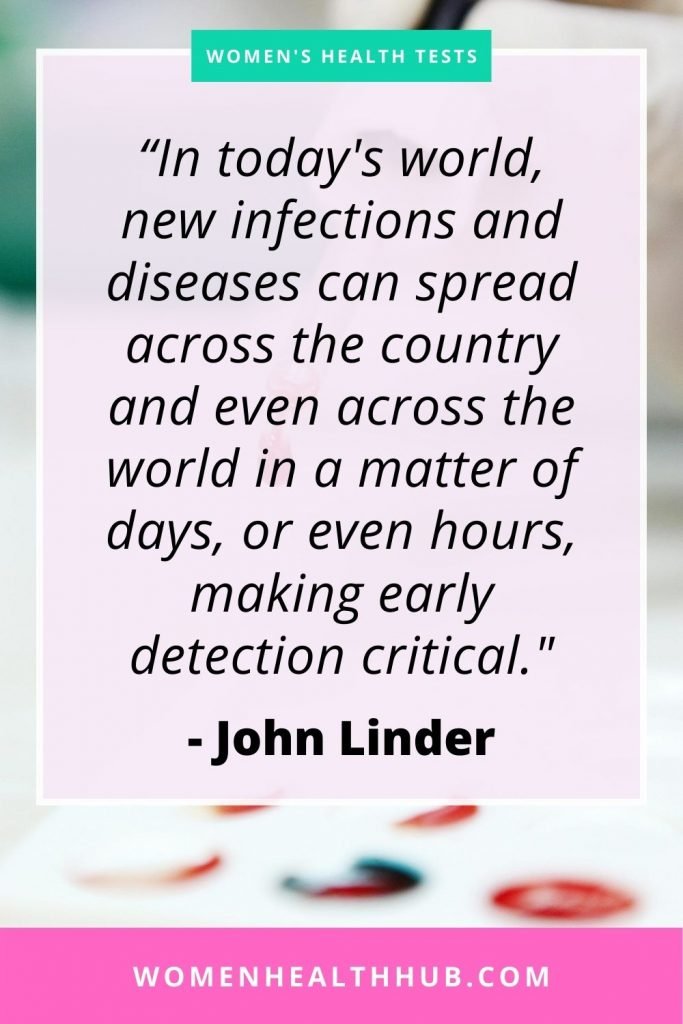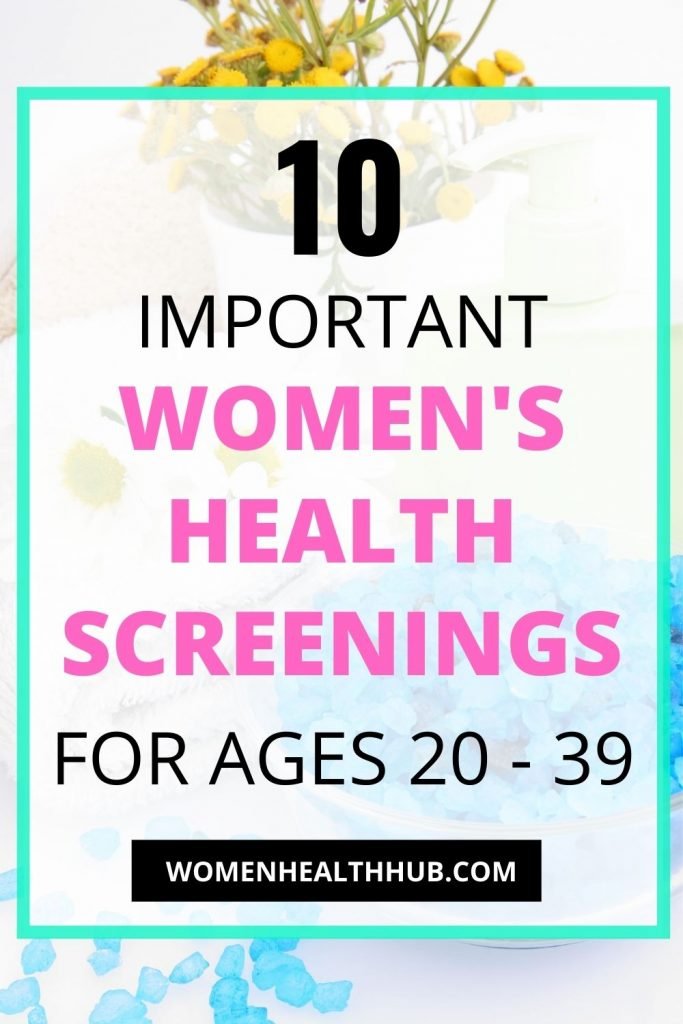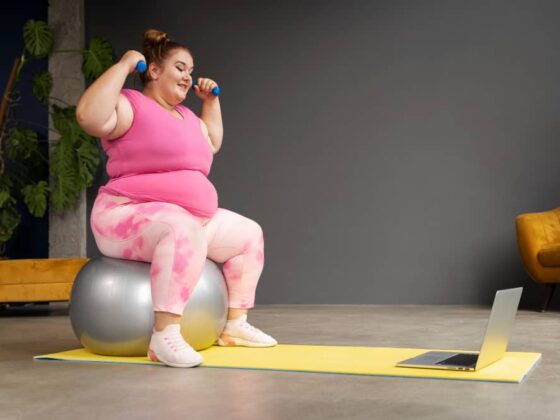Hey there! This post may contain affiliate links. As an Amazon Associate, I earn a teensy commission from qualifying purchases when you buy through these links (at no additional cost to you). For more info, please check the full disclaimer.
Taking care of your overall health can be daunting for women. Luckily, various annual women’s health screening tests make this task a whole lot easier.
In this blog, you’ll learn about the 10 essential female physical exams for women aged 20 to 39 years.
What are Preventive Health Screening Tests?
Your body experiences changes at every stage of your life. Combined with your lifestyle choices and your family’s health history, these factors can put you at risk of diseases and disorders.
However, annual Preventive Health Screenings help detect these dangers at the first instance. These women’s health screening tests involve a series of lab tests, physical exams, and other healthcare strategies to diagnose, treat, or prevent deadly complications.
These health tests empower you to be more proactive about your wellbeing. You can avoid a plethora of serious illnesses such as cancers and heart attacks by going for yearly checkups.
In a way, it helps you take charge of your health before it controls you!
Why are Female Physical Exams Necessary?
If you live in developed countries like the US or UK, you might already be aware of the mandatory women’s health screening tests for 20s and 30s.
But sadly, underdeveloped places like South Asian countries, don’t have proper nationwide guidelines. That’s why more women die in these countries compared to the developed ones.

Here’s another benefit of Preventive Health Screenings.
The government health departments can collect this data and create better healthcare policies for women or modify the existing ones.
It provides the public health experts info on what to prioritize. The analysis promotes better solutions to the most important women’s health problems.
Preventing the spread or severity of diseases is also cost-effective for both the government and you. If you have to pay for your medical out of your pocket, yearly health tests can save you lots!
Can Female Physical Exams Really Prevent Diseases?
Women’s health screening tests have an incredible impact on reducing false diagnosis, treatment costs, and death rates.
For example, after decades of annual female health exams, US saw an amazing drop in cancer rates:
In short, don’t make the mistake of skipping the recommended health screening tests. It may pose drastic consequences on your wellbeing — emotionally, physically, and financially.
How to Prepare for Your Annual Health Screening Tests
You need to know several things before you go for your yearly physicals.
Every health screening exam has unique requirements.
For instance, you might need to fast before some blood tests. Others exams for contagious infections may require you to not have any intimate contact for a week.
At times, you may not even need a particular screening because of least risk. In such cases, it’s best to consult a doctor first.
Bottomline, make sure you’re well-informed about the essentials to avoid any confusion on the day of your physical.
If you keep a record of the yearly health tests manually, then you might want to organize the files. This is particularly important if you get tested at places that don’t keep electronic medical records. Color-code the results or keep them in digitally protected files.

As soon as you reach a new decade, I’d recommend you to make checklists of important women’s health screening tests for ages 20 to 29, 30 to 39, and so on.
Consider your family health history – such as heart diseases, diabetes, breast cancer etc – and consult a professional to set your priorities.
Noting down important self-exams and annual screenings for each year can be super helpful and save you time in the long run.
Keep a diary or a journal and note the dates for your monthly or yearly exams. This way, you’ll not only have a record of your screening history but stay prepared for upcoming tests.
You can also add reminders to your phone using Google Calendar, so you can get ready a few days before the physical. List down the requirements for the test, such as fasting period to ensure the best test results.
10 Vital Physical Health Exams for Women
Now let’s take a look at the most important health screenings for women aged 20 to 39 years.
1. BMI Exam
In the past decade, you might have come across the term “Obesity Epidemic.”
Stats show that more than 70 million Americans are currently obese, out of which 35 million are women. On the other hand, 45 million US women are overweight from a total of 90 million Americans.
Shocking, right?
These numbers have led to various programs on a national level to fight the problem. Michelle Obama started the Let’s Move! initiative to tackle the rise in obesity from childhood.
What is obesity?
Binge eating is one of the biggest causes of obesity worldwide. When you eat lots of oily, fried, or sweet junk but aren’t physically active, this gunk turns to fat and accumulates in your body.
Gradually, what starts off as gaining a few pounds, becomes a huge problem (pun not intended).
Some signs of obesity are:
Obesity is the cause of several diseases such as coronary heart disease, diabetes, and bone problems. In many cases, it leads to pregnancy complications, infertility, or hormone imbalance.
And that’s not all. Obesity is also linked to mental health disorders such as depression and anxiety.
Therefore, BMI is one of the most important women’s health screening tests that can prevent you from various deadly health risks.
What happens in BMI screening?
Your doctor will calculate your BMI by dividing your weight in KGs by height in meters.
It’s then matched against the BMI scale to find whether you’re underweight, normal, overweight, or obese. If your BMI exceeds the normal range, you are at risk of obesity.
The doctor might also ask you about your lifestyle and habits such as smoking, diet, physical activity, mental health issues etc.
Based on this information, you may be asked to eat healthy foods or quit harmful practices to reduce health complications.
You can even give it a try right here using this BMI Calculator.
Don’t forget this super important health screening test for women in 20s!
2. Cholesterol Test
According to the CDC, heart diseases are one of the leading causes of female deaths in the US. In fact, 1 in every 5 women dies because of a heart condition!
This is mostly owed to the alarmingly high cholesterol levels in women. You could – unknowingly – be one of the 45% women aged 20+ years with high cholesterol levels.
But sadly, American Heart Association found that 76% of women don’t even know what a cholesterol test is!
Unhealthy lifestyles such as consuming lots of junk food, smoking, heavy drinking, and sitting for long periods can raise your cholesterol. Other risk factors are obesity, ethnicity, and family history.
What is cholesterol?
Your body contains two types of cholesterols — HDL (High density lipoproteins) & LDL (Low density lipoproteins).
HDL, the good cholesterol, is needed for healthy cell growth. On the other hand, LDL is bad cholesterol. High LDL can block your arteries by forming plaque and prevent proper blood flow. As a result, you might experience various heart problems including heart attack, coronary heart disease, peripheral artery disease, and stroke.
This women’s health screening test is a must for you especially with a family history of coronary issues.
What happens in cholesterol tests?
It is also known as Lipid Profile. You’ll need to fast for max 12 hours before the test. Experts recommend cholesterol screening tests for women every 4 to 6 years.
Cholesterol is measured by taking a blood test to check the amount of HDL & LDL along with certain fats. High levels of LDL is an alarming sign.
Here is what’s measured in a Lipid Profile:
Conclusively, cholesterol is an essential women’s health screening test you should definitely go for once you enter your early 20s.
3. Pap Smear
In 2017 alone, more than 290,000 women in America had cervical cancer. But thanks to the compulsory annual pap smear screening, in 2020 the estimated new cases have dropped to 13,800.
Let’s take a look at why health experts recommend yearly pap smear tests for women.
What is cervical cancer and HPV?
Pap smear is performed to check for any signs of cervical cancer or HPV.
Cervical cancer is one of the most common types of cancers affecting women in the US. It affects the cells of the cervix — a part that connects the uterus to vagina.
Every sexually active woman contracts HPV – a type of STI (Sexually Transmitted Infection) – at some point in her life. In many cases, HPV is the main reason for cervical cancer development.
However, not every woman with this STI gets affected severely.
Just like any other cancer, it’s important to diagnose and treat cervical cancer on time. Otherwise, it may spread to other parts of your body and even cause death.
Women who are under 20 rarely get cervical cancer. But it’s a must-have women’s health screening test between ages 20 to 39, at least once every 3 years.

What happens in pap smear screening?
To perform the pap test, the health professional first places a metal or plastic device inside the vagina to keep it open so they can observe the cervix.
Next, they use a spatula and/or cotton swab to take some cells from the internal lining. These cells are then checked in a lab to look for cervical cancer signs such as HPV.
Here are some things to be mindful of before you go for a pap smear screening:
4. Pelvic Exam
Most women often confuse pelvic exam and pap smear and consider them the same. Truth is, they are both entirely different.
Surprisingly, over the years, annual women’s pelvic screening rates have dropped drastically. In 1988, 65% women went for a pelvic test whereas by 2017, this number plummeted to only 53%!
Research shows that women who’re more educated tend to go for regular pelvic exams while those who’ve less education usually skip them.
What happens in pelvic screening?
A pelvic exam is one of the most highly recommended yearly women’s health screening tests for ages 20+ years.
During the pelvic exam, a gynecologist conducts thorough checkup of your reproductive organs including:
The examiner would check inside of your vagina using gloved fingers while pressing down on your belly and abdomen to feel the internal organs.
Their aim is to look for any common female reproductive illnesses such as uterine fibroids, cervical cancer, ovarian cysts, STIs, and more. If you’re pregnant, you’ll also be called for pelvic checkup often to ensure everything’s good.
5. Blood Pressure
Fluctuating blood pressure is one of the most dangerous and deadliest health problems globally.
In 2017 alone, more than 472,000 people lost their lives to this condition. That’s about 1300 deaths per day!
Continuous changes in blood pressure can lead to hypertension (high blood pressure) or hypotension (low blood pressure). In the long run, they may cause serious heart conditions such as heart attack and stroke.
You may get raised blood pressure for many reasons including obesity and cholesterol. But you can control it successfully by exercising daily and eating nutritious foods.
What is blood pressure?
Blood pressure is the amount of pressure exerted to pump blood throughout your body. It’s measured in two ways:
What happens in blood pressure screening?
Doctors take blood pressure by using an automatic or a manual blood pressure device. After the first blood pressure screening test, you might want to buy your own machine to be aware of the fluctuations in future.
If you’re at high risk of heart diseases, your doctor might advise annual blood pressure checkups. Otherwise, you should at least go once in two years.
These are the normal and abnormal ranges for blood pressure.

Blood pressure is a necessary women’s health screening test for ages 18 years or more. Don’t forget to add it to your list!
6. STIs Screening
It’s among the most popular necessary women’s health screening tests. If nothing else, you must’ve heard of STIs or STDs health tests.
STIs refer to Sexually Transmitted Infections. Once women become sexually active – which is generally in the late teens – they’re at risk of various gential infections.
According to the latest stats by CDC, the rates of STIs in women increased by over 150% (!!!) between 2013 to 2017. To lower these alarming numbers, the first thing to do is go for a thorough genital checkup every year.
What are STIs?
You may get STIs after contracting an STDs (Sexually Transmitted Disease) or vice versa.
Sleeping with multiple partners, not using proper protection during intercourse, not getting timely treatment for STDs or quitting meds can make you prone to severe STIs.
In many cases, improper vaginal hygiene, homosexuality, and anal/oral sex may also cause these infections.
The worst part is that several STIs don’t even show any prominent symptoms in the beginning. It might take weeks for you to notice any signs.
Here are some common STIs you’d get screened for:
Improper treatment or skipping medicines can put you at risk of infertility, internal damage to organs, and even cancers.
What happens in STIs screening?
CDC recommends that women who are under 25 should be examined for gonorrhea and chlamydia every year. If you’re older with multiple partners, you’d have to go for annual exams too.
Yearly HIV screening test are also necessary if you take drugs or have unprotected sex often. Soon-to-be mamas may have to go for frequent screenings as getting an STI during pregnancy may cause harm to your little one.
Homosexuals or bisexuals should get tested for STIs after every 3 to 6 months. In fact, they are more prone to STIs than others.
The STI exam is performed in these ways:
In short, book an appointment for this critical women’s health screening test without delay, to prevent any irreversible complications.
7. Vision Exam

With time as you age, your eyesight weakens. It’s completely natural. You must go for an eye health physical exam regularly to ensure you’re seeing the best you can!
A thorough eye test is essential to prevent diseases, identify any potential hereditary risks to your vision, or simply offer you high or low power contacts/glasses based on your needs.
Why are eye tests necessary?
Generally, in your 20s and 30s you’re lucky enough to have excellent 20/20 vision. Problems start once you hit your 40s — that’s when the lens begins to harden.
Still, if you notice difficulty in reading tv subtitles, medium size fonts, or road signs, you should go for an eye exam.
Poor vision can induce headaches and even cause deadly accidents, such as while driving or at work.
Yearly eye health screening tests help detect any early signs of eye diseases or developing blindness. For example, chronic health conditions like diabetes in women may lead to blindness, if blood sugar levels are left uncontrolled.
If you have a family history of eye diseases, it’s another reason to go for the yearly physical eye health test.
Doctors usually look for following symptoms while performing an eye physical exam:
What happens in eye tests?
According to experts, women’s health screening tests for vision are necessary at least once every 5 to 10 years during 20s and 30s. If you wear glasses or contact lenses, you may need to go more often.
Based on your eye sight and needs, you might get any one of these 3 types of vision screenings:
Doctors use a variety of instruments to assess your visibility strength. Sometimes, they may shine light or ask you to read printed scripts. Other times, they might observe your eye anatomy using special optometry devices.
8. Breast Cancer Screening
Breast cancer is the second most common form of cancer affecting women around the world.
There was a time when this disease only occurred in a fraction of women. But with the changes in our lifestyles and diets, we’ve seen a massive surge in breast cancer cases, particularly in developed countries.
Women’s health screening tests for breast cancer prevent its spread to other body organs such as stomach, increases the survival rate, and significantly reduces treatment costs.
What is breast cancer?
Breast cancer attacks the cells in your breasts by triggering mutated cell growth. It can be seriously risky for your life especially in the later stages, when the cancer reaches adjacent organs.
You’ll find numerous speculations about the cause of breast cancer but the truth is, there’s no one definite answer.
Research shows that if you live a sedentary lifestyle with little to no physical activity or are overweight or obese, you’re prone to breast cancer. Moreover, low number of pregnancies and reduced breastfeeding has also contributed to this rise.
Thankfully, we’ve come so far that with timely detection, doctors are able to cure breast cancer easily using chemotherapy and strong medicines. And sometimes, even a mastectomy (breast surgery) isn’t necessary!
Again, the survival rate depends entirely on when the cancer is identified. The earlier, the better.
What happens in breast cancer screening?
Mammograms are one of the best women’s health screening exams for detecting breast cancers. This test is quite accurate as it relies on advanced imaging techniques using radiation.
During mammography, each breast would be sandwiched between two flat surfaces to spread out the breast tissues. This helps get in-depth images and makes it easier to look for any deep-seated lumps. The scan will be printed out in black and white and sent to your doctor to analyze.

However, experts recommend mammograms for women aged 30 years or more only if:
Otherwise, you could discuss or consult with a health professional so they can guide you on what’s the best option.
For women in their 20s or early 30s, I’d recommend monthly breast self-checks at home. These self-exams allow you to look for suspicious cancer signs such as lumps, nipple discharge, bleeding, misshapen breasts, or red spots.
If you notice anything out of the ordinary, book an appointment with a specialist ASAP! It’s always best to get a few opinions first before going for a mammogram.
Don’t know how to do your breast self-exam at home? Want to learn about the signs of breast cancer?
9. Oral Health Screening
An important yet often ignored women’s health screening test. Surprisingly, it’s quite different from a routine dental checkup.
Oral health screening tests were made mandatory in 2010, to curb the increasing rates of oral cancer. Early detection of oral cancer increases the 5-year survival rate by 82%!
What happens in oral health screening?
A dentist or oral hygienist uses a flashlight and mirror to observe the insides of your mouth. They’ll look for any signs of oral diseases such as cancers, gum problems, cavities, bacterial or fungal infections, or suspicious bumps.
You’ll be asked about the oral hygiene habits, such as how often you floss or brush, what type of brush you use, the method of brushing etc. They might also inquire about your eating habits.
If they find anything, a dentist will then analyze the symptoms and give you a proper diagnosis and treatment.
According to the American Cancer Society, women in their 20s and 30s should go for a comprehensive oral health screening test at least once every 3 years.
10. Skin Cancer
Did you know every day approx 50 people in the US die of skin cancer?
That’s pretty scary!
No wonder skin cancer is the leading form of cancer affecting Americans. However, annual health screening tests can help in early detection of melanoma and raise the survival rate by a whopping 99%.
What is skin cancer?
Skin cancer promotes mutated cell growth in your skin. It’s mostly caused by long-term exposure to UV radiation under sunlight. You should always apply a sunscreen with appropriate SPF to prevent penetration of UV rays into your skin.
Unfortunately, people with low levels of melanin (a compound that gives dark skin tone) are more prone to this disease than the dark-skinned people. That’s why the UK, USA, and Australia have some of the highest skin cancer cases in the world.
You might also be at risk if you burn easily, have lots of freckles, blonde hair, colored eyes, or many moles.
These are the types of skin cancer:
What happens in skin cancer screening?
You can either self-examine for skin cancer or go to a doctor for a proper checkup, especially if you observe any of the above-mentioned symptoms.
A doctor will perform your complete skin screening test to look for any suspicious skin cancer signs including;
I hope this article serves as a handy guide to important women’s health screening tests for ages 20 to 39 years.
Have you (or anyone you know) skipped these exams? How did it affect your health? Share with me in the comments below.
References:
- https://www.cdc.gov/healthyweight/assessing/bmi/adult_bmi/index.html
- https://www.cdc.gov/heartdisease/women.htm
- https://www.mayoclinic.org/tests-procedures/eye-exam/about/pac-20384655
- https://www.cdc.gov/bloodpressure/facts.htm
- https://www.cdc.gov/std/prevention/screeningreccs.htm
- https://www.cancer.org/cancer/cervical-cancer/about/key-statistics.html
- https://www.cancer.org/cancer/cervical-cancer/detection-diagnosis-staging/screening-tests/pap-test.html
- https://www.mayoclinic.org/tests-procedures/pelvic-exam/about/pac-20385135









